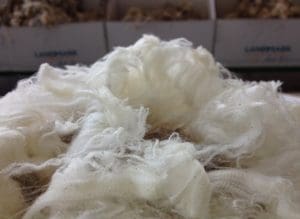
Wool in sale sample. Picture – AWEX.
MANY Australian wool growers again held firm to not sell their clips at still lower prices at auctions this week.
AWEX senior market analyst Lionel Plunkett said with the Eastern Market Indicator’s 20-cent fall to 1854c/kg clean this, the price benchmark had now dropped 169 cents in the past three weeks.
“The EMI has now fallen 262 cents from the record achieved in mid-August and this equates to a reduction of 12 percent,” he said.
Mr Plunkett said the lack of buyer confidence combined with an ever-increasing quantity of lower yielding, lower strength wool, has resulted in losses across the board. The EMI in US$ terms fell 5 cents to US1322 cents.
“By the end of the sale the prices being realised were generally 15 to 40 cents below those achieved at the previous sale.”
He said the fall in prices was again met with firm seller resistance and brokers passed in 16.7pc of the national offering of 35,784 bales, 1262 more than last week. Combined with the 8.6pc that was withdrawn prior to sale, this meant the clearance rate for the week was only 74.7pc, he said.
Mr Plunkett said the skirtings were the best performing sector this week, managing to record modest gains for the week of between 5 and 10 cents. Wool carrying less than 2pc vegetable matter content attracted the most competition and the largest gains.
“The crossbreds had a week of mixed results, prices rose slightly in the south and fell slightly in north,” he said.
The oddments continued their steep downward path. Locks, stains and crutchings generally fell by a further 40 to 100 cents, pushing the three carding indicators down by an average 71 cents.
“Over the course of the previous six sales, the merino carding indicators have fallen by an average of 468 cents,” Mr Plunkett said.
Prices beginning to stabilise – AWI
Australian Wool Innovation’s weekly market report said Australian wool auction sales exhibited some better signals this week as prices began to stabilise somewhat.
“Price in A$ locally continued to fall away a few points, but in all three major foreign currencies used in wool trading, prices finished the week on an unchanged week on week market general indicator basis,” AWI said.
AWI said given wool is generally traded in US dollar terms, the EMI in US$ terms gave a truer indication of the movement of the market.
“Interesting to note though that the forex rate was 0.75pc higher for the week, so in effect you could call it a slightly stronger market and similar numbers were seen in the Euro and Chinese Yuan indicators.”
AWI said demand was stronger from the outset of sale this week, and the tone in the sale rooms was significantly better than what it has been the past few weeks.
“The one caveat on that statement still being seen is the relatively high percentage of the offering being super fine in micron (finer than 18.5 micron), but not reaching European standards.
“Whilst the price has lowered more than most other market segments, these wools are sporadic in demand only,” AWI said.
“Buyer interest is increasing though as the price lowers closer and closer to the 19.5 and 21 micron type area.
“With the price spread shortening to just near 300 cents from 17.5 to 21 micron, overseas manufacturers must surely be eyeing off some of the finer qualities as being of comparatively good to better value than their broader counterparts.”
AWI said a combination of high pass-in rates and a drop in supply has seen a staggering year-on-year decrease in bales sold through auction of 107,577 bales in just the first third of the season.
“By extrapolating those figures against the usual export destination figures, that would mean 81,758 bales less have moved into China than last year at the same time.
“Logic would command that somewhere there must be a drastic under-use of machinery, as stocks of raw material had long ago been depleted,” AWI said.
Next week sees over 35,696 bales being offered to the trade and there are six sale weeks remaining until the Christmas recess.
“The three-week forecast is significant to keep in mind as there is currently just 110,000 bales rostered or 22.2pc fewer than the 141,450 bales offered in the same three-week period last season,” AWI said.
Sources: AWEX, AWI.

HAVE YOUR SAY